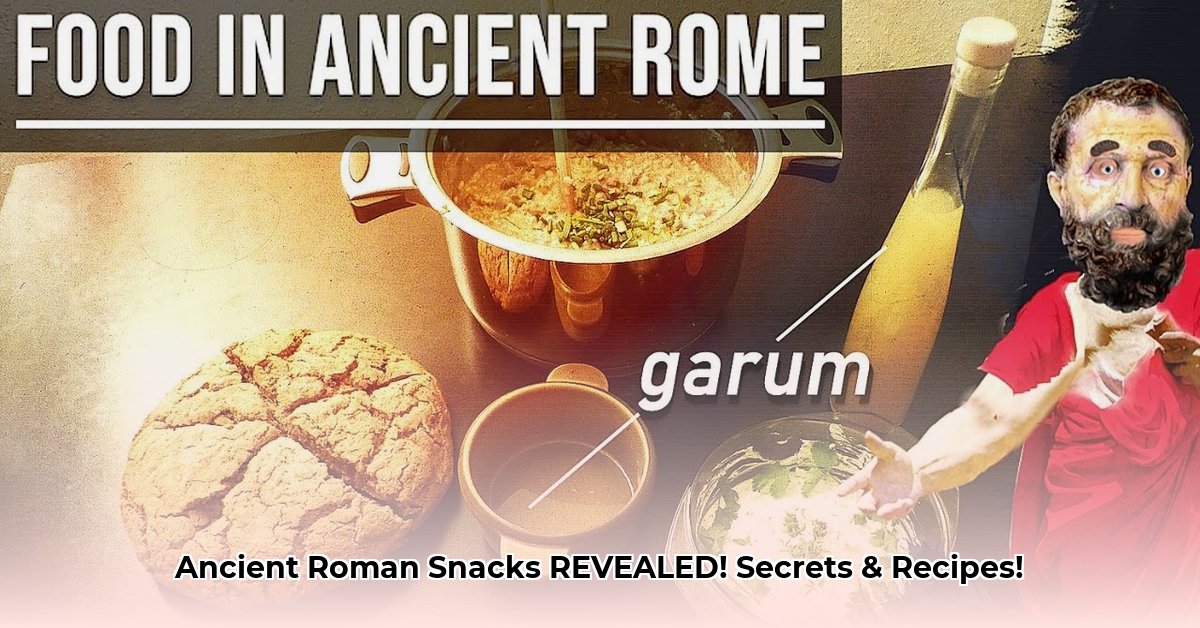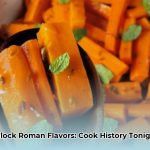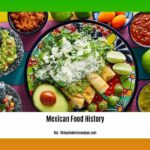Beyond the legendary lavish banquets, the everyday diet of ancient Romans was a fascinating tapestry woven from pragmatic staples, innovative preservation, and a profound sensitivity to social status. From quick, nourishing bites for a soldier on campaign to a senator’s hurried lunch, Roman snack culture was surprisingly vibrant and diverse. Learn more about the Roman Diet. Understanding these daily culinary habits reveals not just what they ate, but how their food shaped their society, health, and leisure.
This comprehensive exploration uncovers key aspects of ancient Roman sustenance:
- Societal Impact on Diet: Food choices in ancient Rome were inextricably linked to social class, dictating access to ingredients, culinary sophistication, and dining customs.
- Grain as the Foundation: Wheat and barley formed the bedrock of the Roman diet, providing the caloric base for daily meals, from simple porridges to artisanal breads.
- Ingenious Culinary Techniques: Romans pioneered advanced preservation methods and developed distinctive condiments like garum (fermented fish sauce) to enhance flavors and extend food availability across their vast empire.
Prepare to journey through the flavors, both humble and exotic, that defined the Roman palate, culminating in accessible adaptations for the modern kitchen.
Daily Rituals and Dining Divisions: A Glimpse into Roman Mealtimes
The rhythm of Roman life, from dawn to dusk, was punctuated by distinct mealtimes that evolved significantly over centuries, reflecting societal shifts and economic prosperity. While a simple breakfast and lunch sustained the working classes, the evening meal for the elite could transform into an extravagant social affair.
The Evolution of Roman Meal Schedules
Traditionally, Romans observed three main meals, though their importance and composition changed dramatically from the early Republic to the Imperial period:
- Ientaculum (Breakfast): Served at dawn, this was typically a modest affair. For most Romans, it consisted of flat, round loaves made from emmer (an ancient wheat species), often with a sprinkle of salt. The upper classes might enjoy their bread with eggs, cheese, milk, or honey, and perhaps some fresh fruit. As the empire grew, more refined wheat bread gradually replaced emmer loaves for those who could afford it.
- Prandium (Lunch): Eaten midday or early afternoon, the prandium was a light meal designed to tide one over until the main evening repast. It often included cold meats, leftovers from the previous day’s cena, cheese, and fruits. For the lower classes, who adhered more closely to manual labor routines, this might have been their most substantial midday break.
- Cena (Dinner): Initially a simple evening meal called vesperna, the cena progressively grew in size and importance, especially among the affluent. With increased importation of foreign foods, it shifted to later in the evening, often around 2 p.m. for the upper classes who typically finished their business obligations and visited the public baths beforehand. This meal could last for hours, particularly if guests were invited, and was often followed by a comissatio—a dedicated session for drinking alcoholic beverages, predominantly wine. For the working classes, who couldn’t afford such leisure, the traditional pattern of a lighter evening meal persisted.
The Ever-Present Grain: From Porridge to Artisan Bread
Grain was the unchallenged cornerstone of the Roman diet, forming the caloric foundation for nearly all social strata.
- Puls (Porridge): In the early Republic, and continuously for the working classes and soldiers, puls was the dietary staple. This thick porridge was typically made from emmer, water, salt, and fat. More sophisticated variations for the wealthy might include olive oil, accompanied by vegetables, or even eggs, cheese, and honey. Roman soldiers, known as hordearii or “barley men,” relied heavily on barley gruel for sustenance, appreciating its density and digestibility.
- Bread: The adoption of wheat bread around 1 AD marked a significant shift from emmer. By the time of Pompeii’s destruction in 79 AD, the city boasted at least 33 bakeries, indicating a thriving bread culture. Quality varied immensely: fine white bread for the elite, darker loaves for the middle class, and the coarsest, darkest bread for the poor. Bread was often dipped in wine and consumed with olives, cheese, or grapes. The state’s management of the grain supply, known as the Cura Annonae, was critical for social stability, providing free or subsidized grain (frumentatio) to up to 200,000 citizens in Rome each month by the 4th century.
The Diverse Palate: Meats, Vegetables, Fruits, and Unconventional Delicacies
Beyond grains, the Roman diet was surprisingly varied, though access to certain foods was a stark indicator of social standing. From common legumes to exotic imported delicacies, the Roman table reflected the vastness of their empire.
Meats: A Luxury for Many
While often associated with grand feasts, butcher’s meat was a luxury for most Romans. The most popular was pork, particularly sausages, while beef was less common than in ancient Greece, as cows were primarily valued for milk and as working animals.
- Common Proteins: Poultry (ducks, geese, chickens) and wild game (rabbit, hare, boar) were more common than domesticated beef or lamb. John E. Stambaugh notes that meat was “scarce except at sacrifices and the dinner parties of the rich.”
- Exotic Delicacies: The truly wealthy indulged in lavish meats such as peacock, flamingo, ostrich, and even dormice. Dormice were considered such a status symbol that some hosts would have them weighed in front of dinner guests, despite sumptuary laws occasionally attempting to curb such extravagance. De re coquinaria, a Roman recipe book, even provides a recipe for stuffed dormice, minced with pork and spices, then roasted.
- Fish: More common than land meat, fish was a significant protein source. Romans developed sophisticated aquaculture, with large-scale oyster farming operations. Highly esteemed fish, like mullet from Cosa, fetched high prices, and elaborate means were developed to ensure their freshness across the empire. Snail farming and oak grub farming also existed.
A Bounty of Fruits and Vegetables
The Roman agricultural landscape yielded a wide array of fruits and vegetables, foundational to nearly all diets.
- Vegetables: Many modern Italian staples trace their roots to ancient Rome. Pliny the Elder discussed a diverse range, including celery, garlic, various cabbages (kale, broccoli precursors), lettuce, endive, onions, leeks, asparagus, radishes, turnips, parsnips, carrots (though not orange), beets, green peas, chard, and cucumbers. However, key modern ingredients like spinach, eggplant, tomatoes, potatoes, and maize were unknown until later introductions from the Arab world or the New World via the Columbian Exchange.
- Legumes: Crucial sources of protein, especially for those who couldn’t afford meat, legumes included dried peas, fava beans (broad beans), chickpeas (with varieties like venus, ram, and punic), lentils, and lupins. They were consumed as broth or roasted snacks.
- Fruits: Eaten fresh when in season, and dried or preserved for winter, popular fruits included apples (three types), pears (at least 35 cultivars), figs (native and imported), grapes, quinces, citron, strawberries, blackberries, elderberries, currants, damson plums, dates, melons, rose hips, and pomegranates. Cherries and apricots arrived in the 1st century BC, peaches in the 1st century AD from Persia. While oranges and lemons were known, their use was primarily medicinal until expanded cultivation in the Principate period. Roman chefs crafted fruit tarts for the upper class and sweet buns flavored with blackcurrants.
Nuts and Dairy: Ancient Staples
Nuts and cheese were also integral components of the Roman diet.
- Nuts: Walnuts, almonds, pistachios, chestnuts, hazelnuts (filberts), pine nuts, and sesame seeds were consumed. They were often pulverized to thicken spiced, sweet wine sauces for roast meats, used in savory pesto-like sauces for cold cuts, and found their way into honey-sweetened pastries, tarts, and puddings.
- Cheese: Its manufacture was well-established by the Roman Imperial period, serving as a standard ration for soldiers and a popular food for civilians. Authors like Pliny the Elder, Varro, and Columella detailed cheesemaking processes, dietary uses, and different types of cheese (soft, new vs. drier, aged). Emperor Diocletian even fixed maximum prices for cheese.
The Art of Flavor: Condiments, Beverages, and Culinary Spaces
Roman culinary ingenuity truly shone in their use of condiments, their approach to beverages, and the design of their cooking spaces. These elements transformed simple ingredients into a diverse and historically rich cuisine.
Garum: The Ubiquitous Flavor Enhancer
The distinctive fish sauce, garum, was perhaps the most iconic Roman condiment. Used as a seasoning in place of salt, a table condiment, and a sauce, it came in various qualities and types (garum, liquamen, muria, allec). Made from fish like tuna, mullet, and sea bass, it could be flavored with wine or diluted with water (hydrogarum)—a favorite among Roman soldiers. The most expensive, garum sociorum, made from mackerel in Spain, was widely traded, with two congii (7 liters) costing 1,000 sesterces—equivalent to 110 grams of gold in the Early Empire. Its powerful umami punch revolutionized Roman cooking, much like soy sauce in many modern Asian cuisines.
Herbs and Spices: A World of Aromas
Roman cooks utilized a wide array of herbs and spices, reflecting their vast trade networks. Common herbs included mint, dill, coriander, and sage. Spices like cumin, pepper (especially from India), saffron, and date derivatives were prized. Honey and vinegar were frequently used to create sweet and sour flavor profiles, adding tang and depth to dishes. Salt, beyond its role as a flavor enhancer, was crucial for food preservation, especially for meats and fish.
Beverages: Wine, Water, and the “Barbarian” Beer
- Wine: The drink of choice for most Romans, consumed at every meal across social classes. It was almost always mixed with water before drinking due to its high alcohol concentration and to improve questionable water quality. Wine was often “improved” with laurel, dates, mastic, or saffron, and special varieties like passum (sweet raisin wine), mulsum (wine and honey mixture), and conditum (aged spiced wine) were popular. Conditum Paradoxum, for instance, included wine, honey, pepper, laurel, dates, mastic, and saffron. Sour wine mixed with water and herbs (posca) was a staple for lower classes and Roman soldiers, praised for its acidity which helped kill germs and prevent spoilage. Elite Falernian and Caecuban wines were highly prized.
- Water: The most common beverage, though its quality could be dubious. Mixing it with wine or vinegar not only improved taste but also helped kill bacteria.
- Milk: Primarily consumed by children or the sick; not considered a suitable drink for healthy adults.
- Beer (cerevisia): Known but largely disdained by Romans, who considered it a “vulgar” drink associated with “barbarians” in the northern provinces.
Roman Kitchens and Cooking Methods
Roman kitchens, particularly in private dwellings, often differed significantly from modern designs.
- Focus (Hearth): Initially, cooking centered around the focus, a hearth placed in front of the lararium (household altar). Some were built into walls, others were portable, rectangular structures of stone or bronze. Over time, as separate kitchens developed, the focus was reserved more for religious offerings and warmth.
- Kitchen Design: At Pompeii, most houses had separate kitchens, ranging from small to quite large (e.g., Villa of the Mysteries’ 9×12 meter area). Many lacked roofs, allowing smoke to ventilate, while roofed kitchens would have been extremely smoky due to reliance on high windows or ceiling holes for ventilation, as chimneys in private dwellings were unknown until the 12th century AD.
- Equipment: Kitchens often featured ovens (furnus or fornax)—square or dome-shaped brick/stone constructions with flat floors. Hooks and chains on walls held a range of cooking equipment: pots, pans, knives, meat forks, sieves, graters, spits, tongs, cheese-slicers, nutcrackers, measuring jugs, and pâté molds. Portable stoves and ovens were also common, some equipped with water pots and grills.
Snacking in Ancient Rome: From Street Food to Elite Indulgences
The concept of a “snack” in ancient Rome covered a wide spectrum, from quick street food to refined treats, all reflecting the profound influence of social class and the era’s culinary technologies.
The Rise of Roman Street Food and Thermopolia
Ancient Rome was a hub of bustling street life, and convenience food was readily available. Archaeological excavations in places like Pompeii, Herculaneum, and the Colosseum sewers have unearthed evidence of a thriving street food culture.
- Thermopolia (Snack Bars): These ancient fast-food establishments, often identified by marble counters with built-in amphorae (terra cotta pots for food storage), were plentiful. They catered to the working class who often lived in insulae (high-rise apartments) without proper cooking facilities, offering hot and cold meals “to go.” Items included lentils, nuts, cooked meats (like sausages), baked cheeses, and mulled wine with saffron and coriander.
- Common Street Snacks:
- Bread and Cheese: A timeless, portable, and nourishing combination, made from locally available ingredients.
- Olives: A readily available Mediterranean staple, often preserved in brine, offering a salty and refreshing bite.
- Dried Fruits and Nuts: Figs, dates, almonds, and walnuts provided quick energy and natural sweetness, easily carried and consumed.
- Farcimina (Roman Sausages): Precursors to modern hot dogs, these seasoned pork sausages were a popular protein-rich street food, often stuffed into bread for easy consumption.
- Proto-Pizza/Focaccia: While tomatoes were unknown, fresco discoveries in Pompeii reveal focaccia-like flatbreads topped with olives, cheeses, fruits, and herbs—a rudimentary form of pizza enjoyed as a quick meal or snack.
- Roasted Chickpeas: A simple, crunchy snack, often roasted and sold by vendors.
- Hard-boiled Eggs: A straightforward and accessible source of protein.
Sweet Indulgences: Desserts and Special Treats
Despite the absence of refined sugar and churned butter, Romans had a distinct sweet tooth, primarily satisfied by honey and fruits.
- Dulcia Domestica (Stuffed Dates): A popular and simple sweet treat, often involving dates stuffed with nuts and drizzled with honey.
- Libum (Cheesecake): A cake made with fresh cheese, flour, and honey, often offered to household deities (Lares).
- Spira: A type of sweet pastry with a thin, cake-like crust, sometimes containing fruit.
- Enkythoi: Softer, sponge-cake like pastries.
- Sweet Wine Cakes: Made with honey, reduced red wine, and cinnamon.
- Fruit Tarts: Popular among the upper classes, but inaccessible for most due to cost.
- Juscellum: A broth with grated bread, eggs, sage, and saffron, described in Apicius. While a broth, its ingredients suggest it could have served as a comforting, quick meal.
- Pancakes (globi): Cato and Galen mention cheese and sesame sweetmeats, and pancakes fried with honey and sesame seeds, highlighting early forms of sweet fried dough.
A Matter of Social Distinction: Snacking and Status
The distinct differences in snack options between social classes were a visible manifestation of Roman hierarchy:
| Snack Category | Upper Class | Lower Class |
|---|---|---|
| Bread | Fine, pure white loaves, sometimes made with expensive imported flours. | Coarser, darker breads, often mixed with other grains like barley or spelt. |
| Meat/Protein | Exotic game (peacock, flamingo), dormice, specific prized fish. | Primarily legumes (lentils, beans, peas), some cheaper cuts of pork, salted fish. |
| Fruits | Fresh, often out-of-season, imported exotic fruits (citron, peaches, early cherries). | Locally grown, seasonal fruits; extensively dried or preserved for year-round consumption. |
| Sweeteners | High-quality honey, expensive imported spices for flavoring. | Relying on naturally sweet fruits; limited use of honey. |
| Preparation Style | Elaborate, multi-step preparations by specialized chefs; often served at banquets. | Simple, home-cooked or purchased from street vendors; minimal processing. |
| Dining Setting | Reclining on couches at formal private banquets. | Primarily seated, often in simple taverns or at home; quick bites on the go. |
Food Future-Proofing: Adapting Ancient Roman Snack Recipes for Today
The rich history of Roman cuisine offers not just a glimpse into the past but a unique opportunity to explore new flavors and sustainable cooking practices in the modern kitchen. Many ancient Roman snacks, with clever adaptations, can be brought to life, delighting contemporary palates while connecting us to millennia of culinary heritage.
Strategic Ingredient Swaps: Capturing Ancient Flavors
Recreating authentic Roman flavors often requires innovative substitutions, as some original ingredients are either unavailable or unpalatable to modern tastes.
- Garum (Fermented Fish Sauce): This strong, savory condiment can be effectively substituted or mimicked. A combination of high-quality fish sauce (such as Vietnamese or Thai varieties, which share similar fermentation principles) with a hint of anchovy paste can approximate its umami depth. For a more nuanced flavor, try a 3:1 ratio of fish sauce to anchovy paste.
- Roman Cumin: While specific ancient varieties might be distinct, readily available ground cumin perfectly captures the earthy, warm notes essential to many Roman dishes.
- Sweeteners: Honey remains the quintessential Roman sweetener. For those seeking alternatives, date syrup or reduced grape must (defrutum) can provide comparable natural sweetness and depth.
Reimagining Sweet Roman Treats
Roman desserts, primarily sweetened with honey and fruits, offer simple yet elegant possibilities for the modern kitchen.
- Dulcia Domestica (Stuffed Dates): Elevate this classic by using plump Medjool dates. For the filling, combine finely chopped walnuts, almonds, or pistachios with a touch of honey and a pinch of cinnamon, nutmeg, or even a hint of rosewater for an exotic twist. A sprinkle of sea salt can balance the sweetness.
- Savillum (Roman Cheesecake): This proto-cheesecake can be recreated using fresh ricotta cheese, providing a light, creamy texture. Mix ricotta with honey, a bit of flour (or semolina for authentic texture), an egg, and a touch of lemon zest. Bake in a water bath for a smooth, crack-free finish, and finish with a sprinkle of toasted poppy seeds.
- Globuli (Honey Fritters): Small balls of dough (flour, water, a touch of yeast) fried and then tossed in honey, sometimes with poppy seeds. Modern adaptations can use ricotta or a simple choux pastry for lighter fritters.
Modern Twists on Savory Roman Bites
The savory side of Roman snacks, rich in herbs and cheeses, offers robust and flavorful options.
- Moretum (Herb and Cheese Spread): This versatile spread is a precursor to modern pesto. Blend fresh herbs like parsley, cilantro, mint, or even basil and oregano (less common in antiquity but accessible today) with softened feta cheese or a combination of creamy ricotta and sharp Pecorino Romano. Add garlic, a generous glug of good olive oil, and a splash of red wine vinegar. Serve on toasted crusty bread or as a dip for vegetables.
- Puls Punica (Carthaginian Porridge): This savory, cheese-forward porridge can be reimagined as a hearty grain bowl. Cook barley or farro until tender. Stir in crumbled feta or goat cheese, a drizzle of olive oil, and fresh herbs like mint or dill. For a fuller meal, add roasted vegetables or a lean protein.
- Roman Isicia Omentata (Hamburger-like Sausage): This ancient delicacy, a seasoned minced meat patty, can be adapted using ground pork or a mix of pork and beef. Incorporate Roman-inspired seasonings like cumin, coriander, and fresh herbs. Pan-fry or grill and serve in a simple flatbread or lettuce wrap.
Adapting for Health and Contemporary Palates
While historical accuracy is interesting, “Food Future-Proofing” inherently involves adjusting for modern dietary preferences and health considerations.
| Adaptation Area | Ancient Roman Dietary Tendencies | Modern Culinary Solution |
|---|---|---|
| Fat Content | Often high, especially in rich dishes and liberal use of olive oil. | Opt for leaner cuts of meat, reduce olive oil quantities (or use judiciously), incorporate more vegetables. |
| Salt Content | Frequently high, particularly with widespread garum and preservation. | Reduce added salt in recipes. Rely more on fresh herbs, aromatic spices, and natural umami from ingredients like mushrooms or aged cheese. |
| Sweetness Level | High reliance on honey for sweetness, which can be intense. | Adjust honey/sweetener quantities to taste. Incorporate naturally sweet fruits for balance. |
| Ingredient Ratios | Recipes were often vague, relying on the cook’s judgment. | Start with estimated modern ratios and adjust by tasting as you cook, prioritizing personal preference and balance. |
| Dietary Diversity | Varied but limited by geography; some modern staples absent. | Embrace a wider range of produce and lean proteins available today to enhance nutritional value and flavor complexity. |
The journey into ancient Roman snacks is more than a historical curiosity; it’s an invitation to explore a surprisingly sophisticated and adaptable culinary tradition. By understanding their core ingredients, flavor profiles, and ingenuity, we can transform these historical recipes into delicious, relevant dishes for the modern table, proving that good food truly stands the test of time.
- Craving Ancient Roman Snacks? Unveiling Secrets & Recipes: Longtail Spotlight - August 15, 2025
- Lost in History? Labeled Ancient Rome Map Reveals Empire’s Secrets Today! - August 15, 2025
- Unearth Ancient City Map Rome: New Atlas For Urban Planners [Reference] - August 15, 2025















